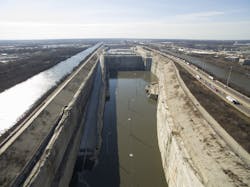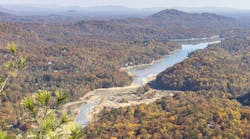Storm Water Fortress
Allison Fore is public and intergovernmental affairs officer, and Patrick Thomas is public affairs specialist for the Metropolitan Water Reclamation District of Greater Chicago. Fore can be reached at [email protected]
or 312.751.6626.
Improving water quality in area waterways and protecting homes and businesses from flooding are the two missions of the Metropolitan Water Reclamation District of Greater Chicago (MWRD), and the organization’s latest 3.5-billion-gal engineering accomplishment achieved both. Since coming into service in December 2017, MWRD’s McCook Reservoir Stage I in Bedford Park, Ill., has captured 27.2 billion gal of water from multiple storms and, combined with the adjoining tunnels that feed into the reservoir, the entire McCook system captured 46.1 billion gal in 2018. Without the reservoir and tunnels, the storm water and wastewater combination could have overwhelmed local sewer systems, causing combined sewer overflows (CSOs) that pollute local waterways and flood streets, homes and communities.
The final piece of MWRD’s Tunnel and Reservoir Plan (TARP), the McCook Reservoir will maintain the largest footprint. The reservoir serves central Chicago and 36 suburban communities, covering a 252-sq-mile area with a population of 3.1 million people. Stage I provides an estimated $114 million per year in flood reduction benefits, while also capturing untreated water that formerly overflowed into waterways in rainy weather. After storms subside, the polluted water that was captured in the system is pumped to MWRD’s Stickney Water Reclamation Plant (WRP), where it is cleaned before being returned to the Chicago Sanitary and Ship Canal.
In February 2019, the MWRD and project partners at the U.S. Army Corps of Engineers (USACE), who worked together to complete Stage I, entered into an agreement on a federal funding plan to complete Stage II by 2029. This second stage of the reservoir will hold an additional 6.5 billion gal, for a total of 10 billion gal of storage, large enough to fill 200 million rain barrels. The McCook Reservoir in its entirety will be 6,400 ft long by 1,000 ft wide by 300 ft deep.
“McCook Reservoir is helping millions of people in Cook County year round,” said MWRD President Kari K. Steele. “It takes on the snowmelt in the winter months and the heavy showers that inundate our communities during warmer months. By relieving us from the burdens of excess water, this engineering marvel is protecting our waterways from pollution and our homes from flooding.”
Expanding Capacity
Formally adopted by the MWRD in 1972, TARP was constructed in two phases, beginning with 109 miles of tunnels that are 150 to 300 ft below ground. The tunnels (Phase I) were then connected to three reservoirs (Phase II). When the Phase I tunnels came online in 2006, they cut the number of CSOs in half and prevented an estimated 85% of the CSO pollution. The first two Phase II reservoirs to be completed—Thornton Composite Reservoir to the south and Majewski Reservoir to the north—have nearly eliminated CSOs in those areas. In fact, the Thornton system has captured more than 99% of the volume of CSO discharges since the Thornton Composite Reservoir was placed into service in 2015. When McCook Reservoir Stage II is completed by 2029, TARP’s final storage volume will be 17.5 billion gal.
The McCook Reservoir is being mined to its massive dimensions by Vulcan Construction Materials through an agreement with MWRD. Mining of Stage I began in 2003. Vulcan mines rock and sells it through its existing McCook Quarry, which has been in business for more than a century. A 2,000-ft-long conveyance tunnel was constructed beneath the Stevenson Expressway (I-55) and the Des Plaines River to connect the reservoir site with the existing McCook Quarry and transport the rock. The aggregate is used in road and building construction projects in the area. Prior to mining the rock, MWRD had to find a home for more than 9.4 million cu yd of overburden and dirt excavated from the site. As part of that work, two man-made hills were constructed to enhance a nearby forest preserve trail.
In addition to collecting the water, it also is necessary to retain it. Retaining walls were constructed to stabilize the overburdened slope around the reservoir. Along the perimeter, thousands of holes were drilled more than 300 ft deep into the rock, then filled in stages from the bottom up with grout under pressure. The grout migrated into cracks and fissures in the rock mass and reduced the permeability, forming a grout curtain. The holes were drilled every 5 ft around the reservoir’s nearly 3-mile perimeter, followed by a second row approximately 15 ft away, angled in the opposite direction to intercept and seal as many cracks as possible. The grout curtain tied into a nearly impermeable natural layer of shale about 325 ft below ground to further prevent water from escaping. A 14,450-ft-long slurry wall was installed around the perimeter of the reservoir between the two rows of grout curtain holes, sealing a roughly 50-ft-deep layer of dirt above the rock to prevent groundwater from entering the reservoir.
Because the reservoir will capture significantly more polluted water, MWRD increased pumping capacity at its Mainstream Pumping Station, conveying the captured water approximately 4.5 miles from the reservoir to the Stickney WRP for treatment. In order to dewater the reservoir to the pumping station, four tunnels were constructed, spanning from a new underground chamber replete with a series of giant gates and valves to control the flow in and out of the reservoir and to and from the pumping station. At 31 ft high, 3 ft thick and 18 ft wide, wheel gates control flow into the reservoir from the 40.5-mile Mainstream Tunnel System. Finally, a solar-powered aeration system was installed to oxygenate the water stored in the reservoir to minimize odors.
Battle Tested
Only weeks into service, the reservoir faced its first test with unseasonable rains in January 2018. Water rushed into the reservoir, demonstrating a fully functioning system. The initial inflow of water entering the reservoir accounted for 263 million gal, but given the reservoir’s size, it marked only a fraction of its capacity.
One month later, the Chicago region was hit by a major storm. A sudden spike in the temperature required MWRD to capture and treat heavy rains mixed with snowmelt and runoff from the frozen ground. Approximately 2.77 in. of rain fell at the Stickney WRP over two days in February 2018, and the McCook Reservoir service area took on an estimated 12 billion gal of water. This did not include several billion gallons of snowmelt that came as a result of 60°F weather. The TARP system captured an estimated 9.2 billion gal of water, and the reservoir provided working relief for a 20-hour duration. Because of the reservoir, MWRD was not forced to reverse the flow of the Chicago River into Lake Michigan to prevent flooding downtown Chicago.
In 2018, the McCook Reservoir took on water on 39 occasions, preventing immeasurable flood damage costs while preventing trash, oxygen-depleting organic material, suspended solids, phosphorus, nitrogen and other pollutants from entering the river system and Lake Michigan. As a result of this project and other water quality enhancements made by MWRD, area residents now see the Chicago Area Waterway System (CAWS) as an environmental, economic and social asset. Marinas, riverfront trails and riverside restaurants were developed; river recreation and tourism are on the rise; and game fish have returned to the CAWS. In fact, since the launch of TARP, the amount of fish species has grown from 10 in 1974 to 77 in 2019, including 60 found in the CAWS since 2000.
However, TARP is not the answer for every flooding problem. Sewer backups may occur for a variety of reasons, ranging from limitations to conveyance of water flow in local pipes, the groundwater table, undersized drainage designs, drain blockages, and roof loads and sump pumps attached to house lines. Now, 3.1 million people are better protected from flooding caused by intense rain events.


